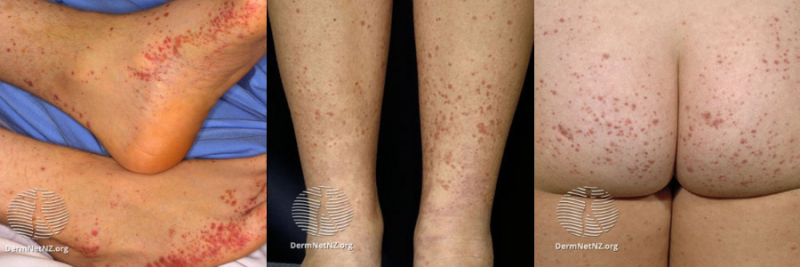Henoch-Schonlein Purpura
Henoch-Schonlein Purpura
If your child has Henoch-Schonlein purpura, you may first notice a rash. This is caused by inflammation and swelling of the small blood vessels in the skin.
Key points to remember about Henoch-Schonlein purpura
- Henoch-Schonlein purpura (HSP) causes inflammation of the small blood vessels
- a skin rash (purpura) is the most common sign
- HSP can also affect blood vessels around the kidneys and intestines
- HSP can cause joint pain
- HSP happens most often in children from 2 to 10 years of age
- go back to your doctor if there is increasing pain or swelling, or blood in your child's poo or wee
- most children with HSP make a full recovery
Most children with HSP make a full recovery.
What is Henoch-Schonlein purpura?
HSP happens because blood vessels get inflamed. This inflammation is called vasculitis. The vasculitis affects the small blood vessels in the skin, causing a rash - red or purple spots, called purpura. It can also affect blood vessels around the joints, in the intestines and in the kidneys.
What causes Henoch-Schonlein purpura?
The cause of HSP is not clear. It might be triggered by bacterial or viral infections, medicines, insect bites or exposure to chemicals or cold weather. It's most common in the spring, usually after an upper respiratory infection, like a cold.
HSP usually affects children from 2 to 10 years of age, but it can happen in anyone. You can't catch HSP from another person.
What are the signs and symptoms of Henoch-Schonlein purpura?
Skin rash
This may start out looking like red spots, bumps or raised skin welts which can be itchy. This quickly changes to small bruises or reddish-purple spots that are often raised. It usually appears on the buttocks, on the legs and around the elbows. Your child could get blisters or ulcers where the rash is.
The rash looks the same as the rash children with meningococcal disease can get. So, if your child has a fever with this rash, call an ambulance.

Pain and swelling in the joints
Pain and swelling in the joints (usually the knees and ankles) which can come and go and can move around from joint to joint.
Tummy pain
This can come and go and in some cases can be severe.
Blood in the poo
This happens because of inflammation of the blood vessels in the bowel. This can be a sign of more serious problems (such as an abnormal folding of the bowel called intussusception).
Blood in the wee
This happens because of inflammation of blood vessels in the kidney. Serious kidney problems don't happen very often, but they can happen.
Swelling
Many children with HSP also have swelling over the backs of their feet and hands, and the scrotum in boys.
How is Henoch-Schonlein purpura diagnosed?
There is no specific laboratory test for the disease. Your doctor will diagnose HSP after looking at your child's signs and symptoms. Your doctor may recommend some blood tests to make sure it's not another condition. If your doctor thinks your child may have HSP, they might test your child's urine to check the kidneys.
What is the treatment for Henoch-Schonlein purpura?
HSP usually gets better without any treatment. Pain relief (such as paracetamol) can help the joint pain. You must follow the dosage instructions on the bottle. It is dangerous to give more than the recommended dose.
Your doctor may recommend a medicine called prednisolone. This can help people with severe stomach pains or very painful joints.
How long does Henoch-Schonlein purpura last?
The illness lasts 4 to 6 weeks in most children. The rash (purpura) changes from red to purple, becomes rust-coloured and then fades completely.
About 3 in 10 children with HSP can get it again, usually within 4 months of the first illness. If your child gets HSP again, it's usually milder and shorter. Children whose kidneys were affected are more likely to get HSP again.
What are the complications of Henoch-Schonlein purpura?
Your doctor will want to check urine samples and blood pressure several times after the HSP goes away to check for kidney problems.
Most people with HSP get better over time without treatment and have no long-term problems. About 5 in 100 children with HSP develop long-term kidney disease (called glomerulonephritis). This may happen in the first week or so of the illness, but there may be a delay of weeks or months before it happens.
Your doctor will want to check urine samples and blood pressure several times after your child gets better. This is to check for kidney problems. Urine and blood presuure checks should happen:
- weekly for the first month after the HSP started
- every 2 weeks from weeks 5 to 12
- at 6 and 12 months
If your child gets HSP again, they'll go back to weekly checks.
When should I seek help for my child with Henoch-Schonlein purpura?
Go back to your doctor or the hospital if your child has one or more of the following, or if you are worried for any other reason:
- increasing tummy pains
- swelling and pain that is not responding to pain relief
- blood in the poo or wee
This page last reviewed 13 June 2022.
Do you have any feedback for KidsHealth?
If you have any feedback about the KidsHealth website, or have a suggestion for new content, please get in touch with us.
Email us now